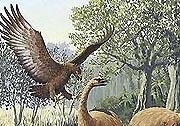A huge flesh-eating eagle that became extinct in New Zealand only 500 years ago was an efficient hunter that could attack prey 10 times its size, UNSW research has found, lending credibility to a Maori legend of a giant man-eating bird.
Research from UNSW's School of Medical Sciences and NZ's Canterbury Museum has confirmed that the Haast's eagle - which had a wingspan of up to three metres and claws the size of a tiger - was indeed a predator and not a scavenger as previously thought.
Skeletal remains of the giant eagle (Harpagornis moorei) were first uncovered by Sir Julius von Haast in the 1870s. CAT scan re-examinations of the remains by Professor Ken Ashwell, from UNSW's Department of Anatomy, and a colleague at Canterbury Museum in Christchurch, revealed that the bird had a strong enough pelvis to support a killing blow as it dived at speeds of up to 80kph.
A disproportionately small brain, olfactory and optic capacity in the Haast's eagle also supports the theory that the giant bird evolved from a much smaller ancestor, most likely a genus of raptors which includes the modern day little eagle and the booted eagle.
The rapid growth in body size was likely due to the abundance of large prey particularly the moa, a flightless bird which grew up to 250kg and 2.5 metres tall.
Maori legend refers to a huge black-and-white predator - the Te Hokioi - that was capable of killing a man.
"That might be stretching things, but it was certainly capable of carrying off a child," Professor Ashwell said.
The investigation was published in the Journal of Vertebrate Paleontology.
To read a fuller version of this story go to the New Zealand Herald.
Media contact: Steve Offner | 02 9385 8107 | s.offner@unsw.edu.au


